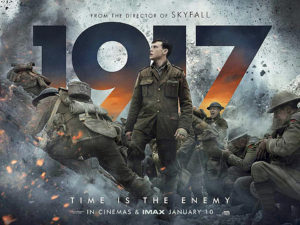 By Steve Crum
By Steve Crum
Sam Mendes’ 1917 is arguably among THE best movies set during WWI ever produced. That exclusive list includes All Quiet on the Western Front (1929), La Grande Illusion (1937), 1960’s Paths of Glory, Wings (1927), and War Horse (2015). 1917’s plot involves a 24-hour life or death mission ordered to two British soldiers. As such, the film is so much more plotted than firing and dodging bullets.
1917 is about humanity, fear, heroics, death, hope, and brotherhood. That last one is particularly apt in regard to 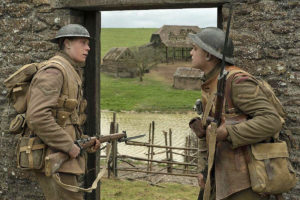 the two soldiers who are 1917’s central characters.
the two soldiers who are 1917’s central characters.
Co-writer Sam Mendez (American Beauty, Skyfall), who also directs and produces, has fashioned a touching and dynamic tale of two British Lance Corporals given the near suicide assignment of delivering a message to British forces sequestered in in a humongous trench miles away. The two must cross enemy German lines (“No Man’s Land”) to save the lives of 1,600 British troops. Lance Corporals William Schofield (George MacKay) and Tom Blake (Dean-Charles Chapman) were particularly chosen since Blake’s older brother, a lieutenant, is among that battalion to be alerted. The message warns of stopping the planned attack on Germans since the Germans have faked their retreat only to lie in waiting for their own surprise attack. As their CO, General Erinmore (Colin Firth) 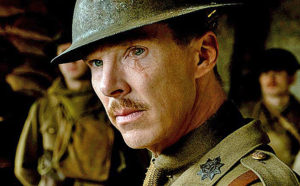 informs them: “They’re walking into a trap. Your orders are to deliver a message calling off tomorrow mornings attack. If you fail, it will be a massacre.”
informs them: “They’re walking into a trap. Your orders are to deliver a message calling off tomorrow mornings attack. If you fail, it will be a massacre.”
Incidentally, the planned recipient of the message, Col. Mackenzie, is portrayed by Benedict Cumberbatch. He and Firth are the only recognizable names in the cast…and they are in very small parts. However, relative unknown George MacKay should attain significant 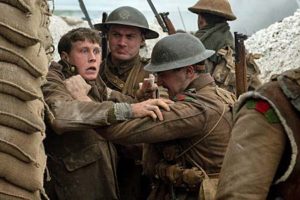 star status due to his terrific acting. It is essentially a solo, star spotlight for him.
star status due to his terrific acting. It is essentially a solo, star spotlight for him.
Mendes based this nearly two hour war drama on stories told to him by his late grandfather, who served with the British Army in WWI. That said, his fictional 1917 work is both credible and incredible. What an adventure.
Within the day’s journey, the two corporals encounter rotting corpses hanging on barbed wire, rats, corpses in ditches, booby traps, snipers, corpses in abandoned buildings, airplanes dogfighting, floating corpses, and the enemy—face to face. The kindness and sensitivity to fellow humans is also shown.
Specifics, as well as the memorable conclusion, will not be divulged here.

But mention must be made of Roger Deakins’ superb cinematography. His visuals are a wow. Who will forget those night scenes in the bombed out French village that appear surreal and nightmarish? The incredible long, long shots of walking and running through the lengthy trenches were accomplished via extended takes and sharp editing by Lee Smith.
Thomas Newman’s moving score is also a plus.
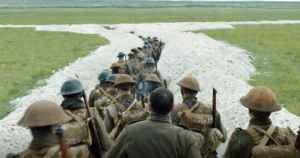 The realism of 1917 is accentuated by filming locations in Scotland and Great Britain. Harking back to the pre-digital effects days, some shots utilized as many as 500 background extras.
The realism of 1917 is accentuated by filming locations in Scotland and Great Britain. Harking back to the pre-digital effects days, some shots utilized as many as 500 background extras.
Both 1917 and Mendes recently won Golden Globes as Best Picture and Director. Why stop here? The Oscars are just around the proverbial corner.
=====
GRADE, On A to F Scale: A
